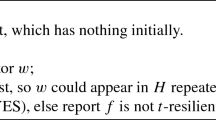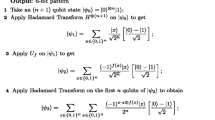Abstract
Recently, Cui and Guo (Quantum Inform. Process. 18, 182, 2019) gave some quantum testing algorithms of multi-output Boolean functions, one of them was for resiliency testing. However, through the algorithm, we cannot get the probability distribution of a Boolean function. Improving the algorithm there, we present quantum algorithms for this problem. Under the condition of non-resiliency, we obtain not only the conclusion that the function F(x) is statistically dependent of which t variables but also the distance of the probability distribution from the uniform distribution.
Similar content being viewed by others
References
Cui, J., Guo, J.: Quantum cryptographic property testing of multi-output Boolean functions. Quantum Inform. Process. 18, 182 (2019)
Grover, L.K.: A fast quantum mechanical algorithm for database search. In: Proceedings of 28th ACM Symposium on Theory of Computing, pp 212–219. ACM, Philadelphia (1996)
Simon, D.R.: On the power of quantum computation. SIAM J. Comput. 26, 1474–1483 (1997)
Siegenthaler, T.: Correlation-immunity of nonlinear combining functions for cryptographic applications. IEEE Trans. Inform. Theory IT-30(5), 776–780 (1984)
Crama, Y., Hammer, P.L.: Boolean Models and Methods in Mathematics, Computer Science, and Engineering. Cambridge University Press, London (2010)
O’Donnell, R.: Analysis of Boolean Functions. Cambridge University Press, New York (2014)
Li, H.: A quantum algorithm for testing and learning resiliency of a Boolean function. Quantum Inform. Process. 18, 51 (2019)
Cramér, H., Wold, H.: Some theorems on distribution functions. J. London Math. Soc. s1-11(4), 290–294 (1936)
Baignères, T., Junod, P., Vaudenay, S.: How far can we go beyond linear cryptanalysis?. In: Lee, P.J. (ed.) ASIACRYPT 2004. LNCS, vol. 3329, pp 432–450. Springer, Heidelberg (2004)
Kurosawa, K., Johansson, T., Stinson, D.R.: Almost k-Wise independent sample spaces and their cryptologic applications. J. Cryptology 14, 231–253 (2001)
Brassard, G., Hoyer, P., Mosca, M., et al.: Quantum amplitude amplification and estimation. Contemp. Math. 305, 53–74 (2002)
Acknowledgments
This work was supported by the Science and Technology Project of Henan Province (China) under Grant (Nos.162102210103, 182102210215), the Soft Science Project of Henan Province (China) under Grant (No.182400410482), the key disciplines construction project of Henan Finance University.
Author information
Authors and Affiliations
Corresponding author
Additional information
Publisher’s Note
Springer Nature remains neutral with regard to jurisdictional claims in published maps and institutional affiliations.
Appendix: Proof of Lemma 1
Appendix: Proof of Lemma 1
For the convenience of description, some notations are introduced first. Let \(\eta =(a_{i_{1}}, a_{i_{2}}, \cdots a_{i_{t}})\), I = It = i1⋯it, \(\alpha =\alpha _{i_{1}}{\cdots } \alpha _{i_{t}}\), \(\text {Pr}[F(x)=y | x_{i_{1}}{\cdots } x_{i_{t}}=\alpha ]=P_{I,\alpha }^{y}\), \(\text {Pr}[F(x)=y | x_{i_{1}}\cdots x_{i_{t}}=\alpha ]-\frac {1}{2^{m}}=\varepsilon _{I,\alpha }^{y}\).
In order to make the proof more clearly, let’s look at some propositions.
Proposition 1
If \(b\in {F_{2}^{m}}\setminus \{0\}\), then
Proof
If b≠ 0, let \(x^{\prime }\in \{x_{1},\cdots , x_{n}\}-\{x_{i_{1}},\cdots , x_{i_{t}}\}\), then
□
Similarly, we have
Proposition 2
If b = 0, and aI≠ 0, then
Proposition 3
If b = 0, and aI = 0, then
On the other hand, by the definition of Walsh transform, we have
Accordingly, S(0, 0) = 1, S(aI, 0) = 0 for aI≠ 0.
1.1 Proof of Lemma 1
Proof
Considering that for any fixed α, β, y, v, we have \({\sum }_{b\in {F_{2}^{m}}}(-1)^{b\cdot (y+v)} \varepsilon _{I,\alpha }^{y}\varepsilon _{I,\beta }^{v}=0\) unless y = v; \({\sum }_{\eta \in {F_{2}^{t}}}(-1)^{\eta \cdot (\alpha +\beta )} \varepsilon _{I,\alpha }^{y}\varepsilon _{I,\beta }^{y}=0\) unless α = β, then
□
Rights and permissions
About this article
Cite this article
Li, H. Quantum Algorithms for the Resiliency of Vectorial Boolean Functions. Int J Theor Phys 60, 1565–1573 (2021). https://doi.org/10.1007/s10773-021-04779-z
Received:
Accepted:
Published:
Issue Date:
DOI: https://doi.org/10.1007/s10773-021-04779-z




